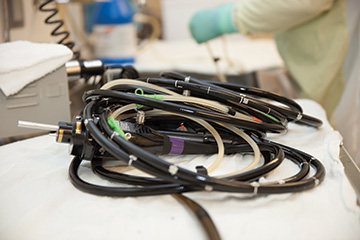This is an article about endoscope reprocessing. You know what that entails by now. Or at least you should. Scopes are wiped down with an enzymatic cleaner at the bedside as soon as procedures end. They’re placed in a secure container for transport to the reprocessing area, where techs examine them for defects, perform leak tests and conduct a thorough manual cleaning before running them through an automatic endoscope reprocessor. Disinfected scopes are then hung vertically in a drying cabinet designed specifically for that purpose. How hard can it be?
Much more difficult than it appears, apparently, because in April the FDA announced investigations into reports of patient infections related to improperly reprocessed flexible urologic endoscopes. That the FDA spotlighted endoscope care serves as another reminder of the importance of endoscope reprocessing — and how concerns about it being done properly persist. That doesn’t mean the hardworking endoscope reprocessing techs in your facility are doing anything wrong. It also means they might not be doing everything right.
“Reprocessing an endoscope is not simple,” says Linda Spaulding, RN, BC, CIC, CHEC, CHOP, an infection prevention consultant based in Lakewood Ranch, Fla. “The entire process involves multiple steps, with each one as important as the next. When multiple steps are involved, multiple things can go wrong.”
Ms. Spaulding is called into surgical facilities across the country when infection rates rise or problems persist in sterile processing departments. She’s spent enough time in endoscope reprocessing rooms to offer an informed opinion about why endoscope reprocessing issues continue. Her feedback is frank and more than a little concerning. “Some facilities still don’t have a good understanding of the importance of proper reprocessing and storage,” she says.
How could that be? The Association of PeriOperative Registered Nurses has issued guidance on proper endoscope care. The Society of Gastroenterology Nurses and Associates also put out a comprehensive multisociety guideline. Both resources contain comprehensive information and provide detailed breakdowns of the many steps your staff must follow to make sure endoscopes are cleaned, disinfected and stored according to the latest best practices.
The issue isn’t that the essentials of endoscope reprocessing are nonexistent or inaccessible. It’s, as Ms. Spaulding says, that they’re not always followed at sinks and storage cabinets. Messing up a single step, no matter how insignificant it might seem, could lead to a cascade of small errors that combine to become a major issue.
.svg?sfvrsn=be606e78_3)

.svg?sfvrsn=56b2f850_5)